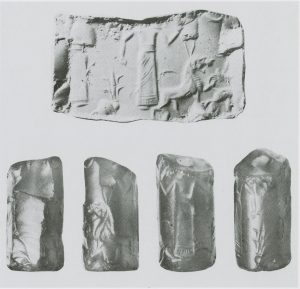
The original was made of chalcedony with longitudinal drilling. Two thirds of a figure in a long, girdled garment with two arrows and a bow, a lion that can be attributed to the Middle Assyrian period, the rear part of an animal with horns (probably a bull) and two thirds of a figure with a long, girdled garment without the right arm, which was probably raised at an angle, are preserved in the impression. Above the lion the remains of a crescent moon can be seen. Behind the two figures stylized plants in vessels, so-called "fleur de lys", are placed. These appear on neo-Babylonian cylinder seals, while the design of the robes can be dated to the neo-Assyrian period. It could therefore be assumed that the seal was created in the Middle Assyrian period and was not completed (or revised) until about 200 years later, at the beginning of the 1st millennium BC. It is in passable shape: The upper end is broken, part of the cylinder in longitudinal direction is missing.
The cylinder seal was found in the former Roman Legion Camp I in Mogantiacum (Mainz). It probably served a Roman legionary of the early Vespasian period as an amulet. It is also possible that it belonged to an oriental archer who belonged to the Mainz garrison.
Published in: E. Künzl, G. Koeppel, Souvenirs und Devotionalien - Zeugnisse des geschäftlichen, religiösen und kulturellen Tourismus im antiken Römerreich (2002), S. 43, Fig.80 [KlArch: B Kuenzl 5].
